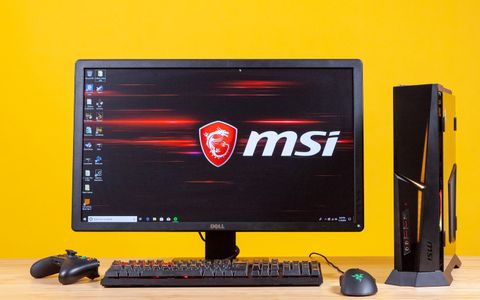Tom's Hardware Verdict
MSI’s Trident X is a powerful, compact machine with standardized parts that you can upgrade. It comes at a price that’s cheap in comparison to similar desktops.
Pros
- +
Compact size
- +
Attractive design
- +
Off-the-shelf parts
- +
Strong performance
Cons
- -
Not tool-free
- -
Lots of bloatware
Why you can trust Tom's Hardware
Powerful parts don’t mean a larger computer. In the case of MSI’s Trident X gaming desktop ($1,999 to start, $2,499 as tested, UK pricing unknown), standardized parts and some innovative case design means an Intel Core i9-9900K CPU and Nvidia GeForce RTX 2080 in a smaller case than competitors and at a cheaper price. With standardized parts, this machine is also easy to upgrade as long as you don’t mind working in cramped cases.
Specifications
| Processor | Intel Core i9-9900K |
| Motherboard | Z370I Gaming Pro Carbon AC Mini-ITX |
| Memory | 16GB DDR4 2,666MHz |
| Graphics | Nvidia GeForce GTX 2080 (8GB GDDR6) |
| Storage | 512GB SSD + 2TB HDD |
| Optical Drive | ✗ |
| Networking | Intel Dual Band Wireless-AC, Bluetooth 4.2 |
| Ports | Front: 1x USB 3.1 Gen 1 Type-C, 1x USB 3.1 Gen 1 Type-A, 1x USB 2.0 Type-A, 1x Mic in/1x headphone outRear: 1x PS/2, 2x USB 2.0, 1x DisplayPort 1.2 out, 1x HDMI 1.4 out, 1x USB 3.1 Gen 2 Type-A, 1x Ethernet |
| Video Output | DisplayPort 1.2, HDMI 1.4 |
| Power Supply | 650W 80 Plus Gold Certified PSU |
| Cooling | 1x case fan, 2x GPU fans |
| Operating System | Windows 10 Home |
| Extras | Optional tempered glass side panelMystic Light RGB design |
| Dimensions | 15.6 x 15 x 5.1 inches (129.7 x 382.7 x 396.4mm) |
| Price As Configured | $2,499.00 (UK pricing unknown) |
Design
MSI’s new design is the rare combination of aggressive gamer aesthetics and simplistic class packed in a surprisingly small chassis. It’s a black monolith with two metal side panels, though one of them is replaceable with an included tempered glass door (I think the glass is far nicer). Of course, there’s also a bunch of RGB, with criss-crossing stripes on the front, RGB that’s easily visible through a window and lighting around the GPU. All of that RGB goodness can be customized (or disabled entirely if you’re not a fan) in MSI’s Mystic Light app.
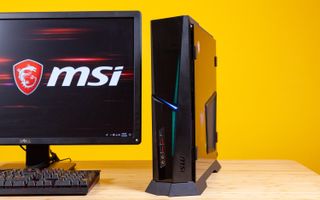
The GPU and its lighting are on the left side of the case, while the fan is on the right side, providing some balance. You can learn more about how the parts are laid out in the upgradeability section below.


At 15.6 x 15.1 x 5.1 inches (129.7 x 382.7 x 396.4mm), the Trident X is compact and noticeably smaller than the 18 x 15.7 x 7-inch (457 x 399 x 177.8mm) Asus ROG Strix GL12CX with similar specs. MSI’s desktop weighs 20.9 pounds (9.5kg).
Ports and Upgradeability
There are a bevy of ports on both the front and back of the Trident X. On the front are a USB 3.1 Gen 1 Type-C port, a USB 2.0 port and a USB 3.1 Gen 1 Type-A port, as well as one headphone and one microphone jack.



On the rear, the motherboard has a suite of audio ports, including S/PDIF out, an Ethernet jack, PS/2 port, HDMI and DisplayPort, a USB 3.1 Gen 2 Type-A port, USB 3.1 Gen 2 Type-C port and a pair each of USB 2.0 and USB 3.1 Gen 1 Type-A. The GPU has three DisplayPorts, HDMI out and a VirtualLink port for VR headsets.
Most of these parts are totally user replaceable with off-the-shelf parts, but they’re packed tight in MSI’s case. If you have the tempered glass panel on, all you have to do is swing it open. Otherwise, each panel has just two screws (though I would have preferred thumb screws).
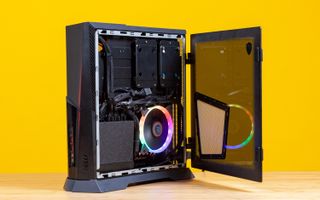
The majority of the internals are accessed from the right side. The Mini-ITX motherboard is mostly obscured by the cooler, which includes a 12mm fan.The CPU and RAM are all under there. To the left of that is a fully modular power supply, and there are two 2.5-inch hard drive trays that screw into a backplate (only one of ours was filled).

On the left side, beneath the side panel, there’s a dual-fan Nvidia GeForce RTX 2080. Below that is the back of the motherboard, where you’ll find the M.2 slot and a bracket for the cooler. The intake for the power supply is also on this side of the case.
Gaming, Graphics and VR
MSI’s version of the Nvidia GeForce RTX 2080 is a bit faster than what we’ve seen in competing systems. It performed well when I played Call of Duty: Black Ops 4’s “Gun Game” at 4K and the game’s highest settings, running between 75 and 85 frames per second (fps).

On the Hitman benchmark (1920x1080, ultra), the Trident X ran the game at at a smooth 143 fps, beating both the GL12CX and desktop average at FHD. At 4K, it ran the game at 78 fps, just a few frames ahead of Asus' machine at 4K.

The Shadow of the Tomb Raider benchmark on the highest presets is tougher. The GL12CX ran the game at 77 fps at 1080p, while the Trident X reached 89 fps. At 4K, the GL12CX fell under the 30-fps playability threshold, but the Trident X just made it.
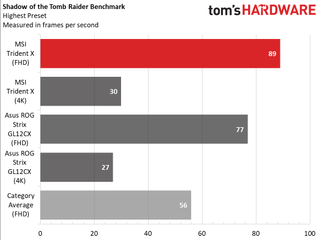
Both the GL12CX and the Trident X crushed Grand Theft Auto V at 1080p and very high settings with 102 and 105 fps, respectively. But at 4K, the GL12CX clunked along at 28 fps, while the Trident X hit a playable 35 fps.
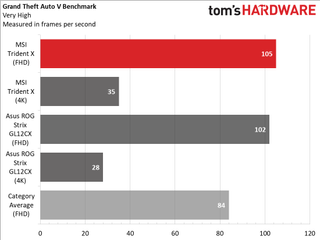
Both desktops reached a perfect score of 11 on the SteamVR performance test, making it Oculus Rift or HTC Vive ready.
To stress test the Trident X, I ran the Metro: Last Light benchmark (1080p, highest possible settings) 10 times on a loop to simulate roughly half an hour of gaming. The computer ran the game at an average of 106.7 fps over the 10 runs, ranging from 103 to 111 fps, but with no steep drop-off. During the test, the CPU ran at an average clock speed of 4.7GHz and CPU temperature of 58.3 degrees Celsius (136.9 degrees Fahrenheit). The GPU’s average temperature was 66.5 degrees Celsius (151.7 degrees Fahrenheit).
Performance
The Intel Core i9-9900K, paired with 16GB of RAM, a 512GB SSD and 2TB HDD, offers incredibly strong performance.
On Geekbench 4, the Trident X (31,581) far surpassed our gaming desktop average (19,955) and came just a head of the the GL12CX.
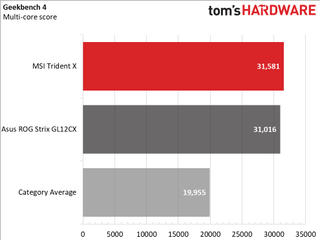
The Trident X copied 4.97GB of files on our File Copy test in 12 seconds--a rate of 424MBps, which is faster than average but still lower than the GL12CX (757MBps).
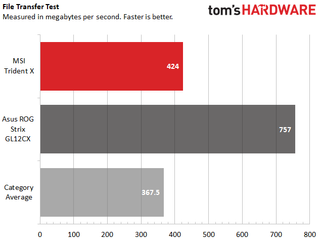
It took 25 seconds for the Trident X to pair 65,000 names and addresses in our Excel macro test, coming out a second behind of the GL12CX and far ahead of the average desktop.

On our Handbrake test, in which we use the program to transcode a 4K video to 1080p, the Trident X was 37 seconds faster than the GL12CX and 1 minute and 5 seconds quicker than the average desktop.
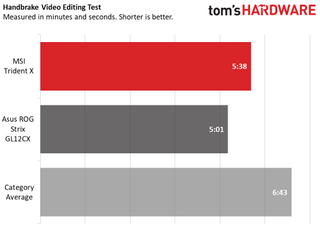
Keyboard and Mouse
While our pre-production review unit didn’t come with a mouse or keyboard, customers will get peripherals in the box. The keyboard is an MSI Interceptor DS4200 with membrane switches and backlighting. The mouse is the MSI Clutch GM10 with just two buttons and a switch for DPI adjustment.

Software and Warranty
MSI’s software load includes a number of gaming-specific utilities, including Dragon Center for system monitoring, device information and tuning your system. MSI also includes Nahimic for adjusting audio for games and music and Mystic Light to customize the system’s RGB lighting.
But there’s also a bunch of extra junk the company pre-loaded, including a trial of Norton Studio, PhotoDirector 8, PowerDirector, Minesweeper, Sudoku, a Translator app, Microsoft Jigsaw and Evernote.
MSI sells the Trident X with a one-year warranty.
Configurations
I reviewed the top-end MSI Trident X, a $2,499 machine with an Intel Core i9-9900K CPU, Nvidia GeForce RTX 2080 GPU with 8GB of GDDR6 memory, 16GB of DDR4 RAM at 2666MHz, a 2TB HDD and 512GB M.2 SSD.
The base model is $1,999, with a Core i7-7700K, RTX 2070 and a 512GB SSD, but no HDD.
For $2,299, you get the same Core i7 CPU as above, an RTX 2080 and a smaller 256GB SSD alongside a 2TB HDD.
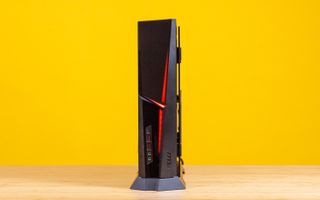
Bottom Line
MSI’s Trident X puts a bunch of powerful parts in a compact chassis. And with almost entirely standardized parts, it's easy for you to upgrade it later, assuming you can deal with a lack of working space. And of the desktops we’ve tested with RTX 2080 cards so far, it’s the most affordable option.
Your alternative at the moment is Asus’ ROG Strix GL12CX, a great computer with a hot-swappable SSD bay and Aura Sync RGB software. But not only is it larger, it’s also a lot more expensive--$1,300 more for a configuration similar to what we reviewed.
That makes the Trident X the obvious choice for its looks, price, strong performance and upgrade potential.
MORE: Best Gaming Desktops
MORE: How To Build A PC
MORE: All PC Builds Content
Photo Credit: Tom's Hardware
Andrew E. Freedman is a senior editor at Tom's Hardware focusing on laptops, desktops and gaming. He also keeps up with the latest news. A lover of all things gaming and tech, his previous work has shown up in Tom's Guide, Laptop Mag, Kotaku, PCMag and Complex, among others. Follow him on Threads @FreedmanAE and Mastodon @FreedmanAE.mastodon.social.

AMD-powered classic Macintosh System 1-inspired mini PC available for retail — Ayaneo's new AM01 released after a successful Indiegogo campaign

Raspberry Pi Compute Module 4S memory variants announced

TSMC's labor practices draw serious concern in Arizona — the company's new chip plant allegedly plagued by worker abuses
-
jdlech2 Sudoku, Microsoft Jigsaw...Reply
That comes from the xbox app standard to W10. Their xbox app is also adware for MS. I've had to uninstall Sodoku in order to get it to stop serving me ads. -
2Be_or_Not2Be The article shows a pretty big disparity on the File Copy test. Can you tell us what models of SSD are being used, or at least identify why there was a significant difference?Reply
